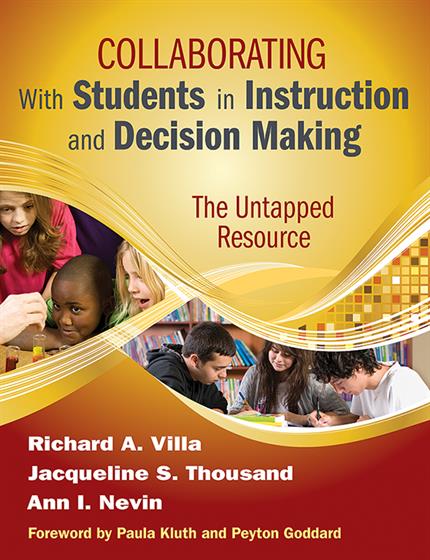Foreword: The Importance of Students' Voices by Paula Kluth and Peyton Goddard
List of Tables
List of Figures
Acknowledgments
About the Authors
I. Introduction
Letter to the Reader
1. Why Collaborate with Students?
Rationale #1: Student Collaboration Facilitates 21st Century Goals of Education
Rationale#2: Student Collaboration is Democratic Schooling
Rationale #3: Student Collaboration Increases Self-Determination
Rationale #4: Student Collaboration Increases Academic and Social Competence
Rationale #5: Student Collaboration Facilitates Other School Reform Efforts
Rationale #6: Student Collaboration is an Untapped Resource in Times of Limited Fiscal and Human Resources
Summary
II. Teaching With Students
Definition of Teaching
What is the Instructional Cycle?
What is the Research Base for Teaching with Students?
2. Students as Co-Teachers in Cooperative Learning Groups
What is Cooperative Learning?
What Cooperative Groups Are NOT
Five Essential Ingredients of Cooperative Group Learning: PIGS Face
The Four Phases of Planning and Implementing Formal Cooperative Group Lessons
Teacher Decisions at Each Phase of Planning and Implementation
An Example of a Formal Cooperative Group Lesson
What Do Students Say About Cooperative Group Learning
Summary
3. Students as Peer Tutors and Partner Learners
Meet Some Peer Tutors
What is Peer Tutoring/Partner Learning?
Essential Ingredients of Peer Tutoring and Partner Learning
Getting Started with Peer Tutoring and Partner Learning
An Example of a Peer Tutoring/Partner Learning Lesson
Students' Views of Peer Tutoring and Partner Learning
Summary
4. Students as Co-Teachers
What is a Co-Teacher? What are Examples of Adults Co-Teaching with Students?
Co-Teaching Approaches
Challenges Faced by Student Co-Teachers
What Are Student Co-Teachers, Adult Co-Teachers, Administrators, and Learners in Co-Taught Classes Saying About Co-Teaching?
Summary
III. Decision-Making With Students
5. Empowering Students as Collaborative Creative Thinkers
Barriers to Creative Thinking and Action
Awareness Plans for Busting Barriers and Imagining Improvements
Osborn-Parnes Creative Problem-Solving (CPS) Process
Thinking for Collaborative Solution Finding—Focusing Upon What You Can Do
Summary
6. Students as Instructional Decision Makers
Collaborating with Students to Determine the Product of Learning
Collaborating with Students to Differentiate Instruction for Struggling Learners
Summary
7. Students as Designers of Their Own Learning
Defining and Nurturing Self-Determination
Making Action Plans (MAPs) as a Tool to Actualize Self-Determination
Student-Led Individualized Education Programs
Personal Learning Plans as a Tool to Teach Self-Determination
What Do Students Say About Self-Determination?
Summary
8. Students as Mediators of Conflict and Controversy
Examples of Everyday School Conflicts
Understanding Conflict
An Example of a Class-Wide or School-Wide Peer Mediation Program
A Lesson Plan Example: Learning Friendly Disagreeing Skills
Summary
9. Students as Collaborators in Responsibility
A "Circle of Courage" Definition of Responsibility
The Self-Discipline Pyramid
Summary
Epilogue: Beyond Benevolence to Befriending
Glossary
Resources
A. Cooperative Group Learning Lesson Plan
B. Peer Tutor Lesson Plan
C. Co-Teaching Lesson Plan
D. Syllabus for High School Course for Teaching Students to Be Co-Teachers
E. Template for Product-Activity Matrix Integrating Bloom’s Taxonomy and Gardner’s Multiple Intelligence Theory
F. Template for Facts about the Learner, Classroom Demands, Mismatches, and Potential Solutions
G. Student Collaboration Quiz (for students)
References
Index




